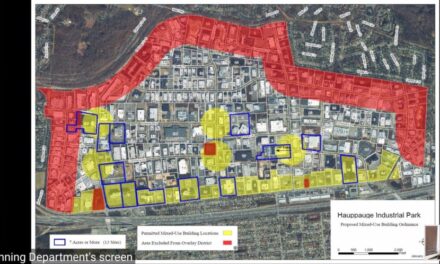The following was first published on The Foggiest Idea on February 7, 2018.
From a financial perspective, Suffolk County isn’t doing so well.
Thanks to years of exorbitant budgets, declining sales tax revenues and what some would argue to be reckless spending, the county is in a fiscal hole to the tune of $1.4 billion. According to Newsday’s editorial board, this whopping figure doesn’t even include hundreds of millions of dollars in borrowing the County has already done or plans to do.
Meanwhile, the Suffolk County Industrial Development Agency, a public benefit corporation, seems to be well off enough to outsource ample amounts of planning work to the Regional Plan Association, the Manhattan-based think tank that explores development-related issues in the New York metropolitan area. It’s important to note that the operations of the IDA are not supported directly by taxpayer funds. Instead, the IDA is funded by fees generated by applicants seeking to take advantage of the IDA’s benefits.
The consulting work doesn’t come cheap. A recent study commissioned by the IDA to examine mixed-use residential development in the Hauppauge Industrial Park will cost $100,000.
This isn’t the first time the RPA received work from the county IDA. Other efforts outsourced to the RPA include studies of Amityville, Lindenhurst, Kings Park, Smithtown, the Route 110 corridor and other areas. According to Newsday, the Lindenhurst study alone cost the county $200,000. The Hauppauge Industrial Park was already studied by the RPA as part of this larger effort.
When this suburban industrial park was built nearly 50 years ago, it was one of the first of its kind. Since then, it has become a vital economic hub for the region, boasting 1,350 companies employing roughly 55,000 people. Perhaps to open more doors to more workers, the Town of Smithtown recently rezoned the area to allow taller buildings in the park.
Outsourcing the study to RPA doesn’t make sense because the Suffolk County IDA already has access to the county’s in-house municipal planning department for just such services. Further, Smithtown has its own capable planning department, headed by David Flynn, a seasoned and experienced planner who has worked with the municipality since 1977. It is likely that the county’s planning department would happily work with the IDA as needed because they share a mutual goal to boost the economy.
Based on the fundraising appeals that the RPA regularly sends out, the group must need the cash. Their glossy Fourth Plan, a comprehensive vision for the New York metro region released in November 2017, got a tepid response from Newsday, which criticized the group for failing to provide cohesive recommendations for Long Island. All told, it’s troubling that the RPA has become the go-to resource for Suffolk when it comes to planning.
That’s not to say that the group isn’t without its merits. The RPA has been influential in shaping the New York metro region since its first plan was drafted in 1929. Since then, their conceptual efforts paved the way for projects like the placement of the George Washington Bridge, the Verrazano-Narrows Bridge, the creation of the Metropolitan Transportation Authority, East Side Access, the development of Manhattan’s Far West Side, and more.
Meanwhile, the IDA itself is quick to tout its success, claiming in September 2017 that the agency retained or created more than 12,700 jobs within Suffolk County. Skeptics aren’t impressed, and some have claimed that the IDA’s metrics are easily disproven.
In the past, the RPA’s approach to planning has been largely NYC-centric, with Long Island among the city’s many “environs.” But the association seemed to move away from that orientation with its Fourth Plan, which calls for improving transit ties between the Island and Manhattan as well as strengthening coastal protections. That being said, just because they know how to shape the region on the macro level doesn’t mean they should do it locally.
After a real estate panel discussion in Hauppauge on November 2017, Kelly Morris, the deputy executive director of the Suffolk IDA, told The Foggiest Idea that the RPA’s involvement was supplemental. Morris, who previously worked in the City of Glen Cove’s IDA, noted that the RPA will serve as a “seed” to jumpstart local planning.
Months later, it’s clear the arrangement hasn’t sprouted anything earth-shaking. Essentially, the IDA is putting applicant fees to use by paying an outside group to suggest that housing be integrated in the industrial areas, an arguably shaky planning concept fertilized by over-eager developers who’ve grown hungry as vacant land has gone increasingly scarce.
In Hauppauge, increasing housing in the park makes sense on paper – the theory being that people want to live where they work. In practice, however, the notion doesn’t hold much weight, given the realities of locating homes near active manufacturers. After all, this is an industrial park, not a quaint residential neighborhood.
Economically, suburban industrial markets are booming, driving up both demand and cost so the study’s proposal for these properties is inopportune.
Given RPA’s track record, the group is very good at pushing the big concepts. But it has trouble implementing its ideas at the local level because it has a history of regarding suburban areas like Long Island as nothing more than New York City’s “environs.”
More problematic is that industrial parks require a range of support services, such as big rig tractor-trailers and constant truck traffic, and they yield manufacturing odors and noise when they’re being most productive. So, sticking to traditional Euclidean zoning—separating commercial, residential and industrial uses—makes sense here.
It’s not like Suffolk’s planning department is an amateur outfit, either. From the booming Sixties through the Nineties, these county planners set national policy precedents in the preservation of open space and groundwater, as well as promoting a deeper understanding the environmental impacts of growth. Despite slashed civil service rosters and scaled back budgets, the county’s professional planners are still capable of producing work that lives up to their reputation. However, when Suffolk County Executive Steve Bellone decided to merge the planning department with the economic development outfit, the intent of the administration and its sister agencies became clear: Build now, plan later.
The trouble is that by outsourcing its planning process, the Suffolk IDA is shortchanging the one county agency with the professional objectivity, the local expertise and the mandate to truly put the public interest first—and even if the money doesn’t add up to millions, we could all be the losers in the end if the outsiders got it wrong.
Richard Murdocco is an award-winning columnist and adjunct professor in Stony Brook University’s public policy graduate program. He regularly writes and speaks about Long Island’s real estate development issues. More of his views can be found on thefoggiestidea.org or follow him on Twitter @thefoggiestidea. You can email Murdocco at Rich@TheFoggiestIdea.org.










Although I agree with the majority of the article, specifically that living in an industrial park is ridiculous, I disagree with your praise of the Suffolk County Planning Dept. They approved Heartland unanimously, disregarding the fact that they and the Islip Town Board have voted to change the face of Long Island for those who moved here for the suburbs. For those who are uninformed, let me report that there are tens of thousands of so-called “affordable” projects across Long Island. And, note that I am suspicious of a unanimous vote from both boards for Wolkoff’s astronomical project.
Why did you shut down Natalie’s and my comments ? Where is the string so as your response makes sense. It doesn’t make any sense. This is censorship at its basic.
Nowhere in your article do you mention that RPA used Mastic Beach in it’s 2017 report. They specifically dealt with the very real and immediate danger that Sea Level Rise is causing in this low lying Wetland community.